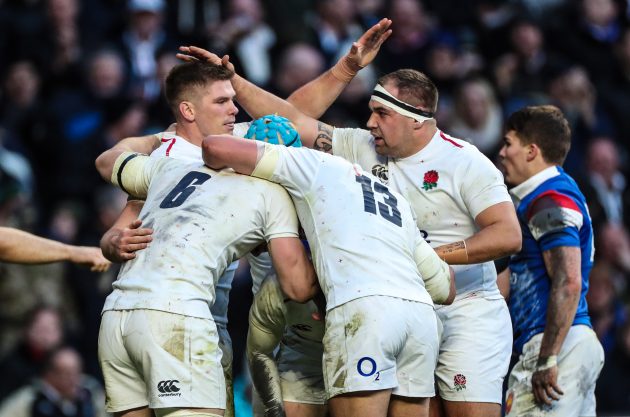It's 150 years since England took part in the first rugby Test Match. To celebrate their sesquicentennial, there's a new book out charting the fortunes of the Red Rose nation
Happy 150 – the rich history of English rugby
It’s a landmark year for England and Scotland because 27 March signalled 150 years to the day since the countries contested the first rugby International ever played.
Raeburn Place, home of Edinburgh Accies, hosted the two 20-man teams, the Scots winning by a goal and a try to a try in front of 4,000 spectators. The participants that day – England’s side contained 11 old boys of Rugby School – cannot possibly have conceived of what had they started, with the sport now played by more than 8 million people across the globe.
While the SRU marked the anniversary with a wide range of digital initiatives, the RFU have produced a splendid history book, England Rugby 1871-2021: 150 Years, in conjunction with distinguished publishers Vision Sports Publishing.
Written by Phil McGowan and Richard Steele, respectively curator and researcher at the World Rugby Museum, the lavishly illustrated ‘coffee table’ book is impeccably presented and leans on a bibliography of around 200 previous works.

Jess Breach takes a selfie as her England team-mates pose with the 2021 Six Nations trophy (RFU/Getty)
There is a welcome message from RFU chief executive Bill Sweeney, whose eclectic club CV comprises Aberdeen, Abu Dhabi, Rosslyn Park and Weybridge Vandals.
It’s amusing to think that the average age of those at the inaugural RFU meeting in 1871 was just 23, and that many selected themselves to face Scotland. Blackheath’s Fred Stokes was 20 when he captained England in the famous match and 24 when he became RFU president!
His brother Lennard was England’s first ‘star’ player and held the country’s conversions record for 100 years. There is a profile of him in the book, as too with a host of legendary names from across the eras.
They include England’s first two Grand Slam-winning captains from 1913 and 1914, both of whom died in world wars. Norman Wodehouse drowned after his ship was sunk by a U-boat in 1941 while Ronnie Poulton-Palmer was killed by a sniper in 1915, three weeks after playing his final game of rugby in Nieppe on the French-Belgian border. Soil from Twickenham lies at his grave in Belgium, placed there by World Rugby Museum ambassador Lewis Moody.

The Core Values sculpture, unveiled in June 2010, is a popular meeting point at Twickenham (Getty)
The poignancy associated with conflict is a strong theme of the book. In 2015, the World Rugby Museum staged an exhibition in tribute to the 27 England internationals and many more from other nations who died in the Great War. It featured the painting Forever England that depicts the 1914 England side that clinched the Grand Slam in Paris. Six of the side didn’t return from the war and are identified by darkened roses on their jerseys.
There is a panel explaining the history of the rose emblem – in the early days, players bought their own and sewed them onto the jersey. The panels crop up throughout the book and cover everything from how the Calcutta Cup came about, dual cricket/rugby internationals, referees, siblings, the sculptures and memorial gates at Twickenham, and the history of England & Wales v Scotland & Ireland matches.
Younger readers may be unaware that the home unions used to pair up for centenary games. The last such occasion was 1980, when England & Wales beat Scotland & Ireland 37-33 with the help of Bill Beaumont’s only international try. Watch highlights of the match below.
Rows and divisions were as much a part of the rugby landscape in the early days as in the modern era. There was the contentious try in the 1884 England-Scotland match that led to Scotland cancelling the next fixture. And another controversial moment occurred against the 1888-89 New Zealand Natives, when England scored a try while the rest of the team were shielding AE Stoddart as he put his shorts on. The visitors were so incensed when it was awarded that three of them walked off the field.

A spread from the book on the NZ Natives game. The painting depicts the 1886 Scotland v England match
The Great Schism – the north-south rift that led to the start of rugby league – is covered in depth, of course. It’s interesting to note that Yorkshire (seven) and Lancashire (one) won the first eight editions of the County Championship, and that the England team that thrashed Wales in 1892 contained 11 northerners. That year England won the Triple Crown without conceding a point – the only time that has happened.
There is a treasure trove of photographs in the book, a particular favourite being the sea of people packing the completed two-tier West Stand in 1927 as they watched a match. So many faces and so many hats!
Twickenham had opened in 1909, with a Harlequins-Richmond fixture. Eighty-two years later, Chris Hewett, at that stage still to become an award-winning rugby journalist, found himself ticketless as he contemplated how to get into the 1991 England-France Grand Slam decider. The answer? He took advantage of “an elderly turnstile operator who was too engrossed in his bacon sandwich to notice that the ‘ticket’ produced for the briefest of inspections was in fact a packet of seeds. A variety of garden pea rings a distant bell”.
Other notable rugby journalists, among them Rugby World editor Sarah Mockford, have provided essays on topics such as the England head coaches, the impact of professionalism, and England’s most capped players, Rocky Clark and Jason Leonard.
Leonard, incidentally, is in elite company: Ronald Cove-Smith, Dave Davies, Cyril Lowe and the current Lions chairman are the only English men’s players to win four Grand Slams.
Related content: Jason Leonard’s Life in Pictures

Jason Leonard passes during an England training session in Perth at the 2003 World Cup (Getty Images)
As the book wends its way towards 2021, there’s a bundle of content on the women’s game that took root in 1984 through some enterprising students at University College London. The first women’s International, GB v France at Richmond, took place two years later and 1987 saw England’s first women’s match, a 22-4 win over Wales in Pontypool.
Their World Cup victories of 1994 and 2014 are given suitable billing, so too the men’s triumph in 2003 when Sir Clive Woodward’s team racked up a 12th successive win against the southern hemisphere’s Big Three in the final against Australia.

England’s finest hour – the 2003 World Cup win in Australia that made Jonny Wilkinson a household name
There were shades of Barry John in Jonny Wilkinson’s aversion to the personal adulation that greeted him after his famous drop-goal. Somehow the reluctant hero was persuaded to appear on Michael Parkinson’s chat show. Parkinson later related how no one – not even one of Hollywood’s finest – ever received a standing ovation as thunderous as that given to Wilkinson as he descended the stairs on the TV set to be interviewed.
As with the blizzard of player profiles, the World Cup finals and Grand Slam clinchers are given special prominence alongside other epic games like Obolensky’s match in 1936 and Sharp’s match in 1963.
In February 2010, England played in sponsor-free heritage jerseys against Wales to mark 100 years since the first Test at Twickenham. England won 30-17, with two tries by James Haskell, in a match watched by 81,000 fans instead of the 20,000 from a century earlier.

James Haskell hands off Gareth Cooper during the 2010 England-Wales match at Twickenham (Getty)
Just as the stadium helped the national cause in World War Two, when it was used as a Civil Defence Depot, so it did again over the past 12 months, the West Car Park becoming an NHS national testing centre.
The book ends with a list of every player to have represented England at senior level.

England Rugby 1871-2021: 150 Years is published by VSP, RRP £30. It makes a super addition to any discerning fan’s book collection. There is also a collectors’ edition signed by World Cup winners Martin Johnson and Katy Daley-Mclean that comes in a luxurious box (RRP £65).
Can’t get to the shops? You can download the digital edition of Rugby World straight to your tablet or subscribe to the print edition to get the magazine delivered to your door.
Follow Rugby World on Facebook, Instagram and Twitter.





